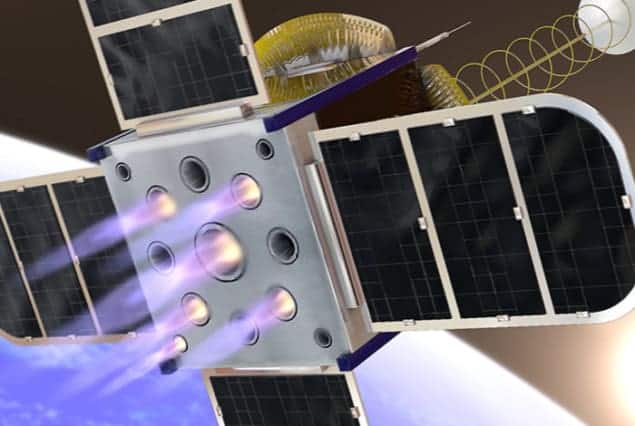Flash Physics is our daily pick of the latest need-to-know developments from the global physics community selected by Physics World‘s team of editors and reporters

CubeSats could soon have on-board propulsion
CubeSats – small, low-cost satellites – could soon become self-propelled, thanks to a rocket-motor concept developed by researchers at Los Alamos National Laboratory in the US. While CubeSats are a cheap and easy way for relatively small research groups to launch satellites and access space, they traditionally do not have any on-board propulsion system – the nanosatellites are usually launched via a larger satellite and simply released into a specific orbit. “The National Academy of Sciences recently convened a meeting to look at science missions in CubeSats,” says Bryce Tappan, lead researcher of the CubeSat Propulsion Concept team, “and identified propulsion as one of the primary categories of technology that needs to be developed.” Recently, the Los Alamos researchers successfully tested a six-motor CubeSat-compatible propulsion array and according to Tappan, they are very close to being able to take the next step and show that the propulsion system works on a satellite in space. One of the main problems with CubeSat propulsion is that of safety – the fuels used in any such system are intrinsically hazardous ones such as hydrazine, and as multiple CubeSats are deployed by piggybacking on a larger mission, even a small margin of risk can be disastrous. To avoid these issues, Tappan’s team is developing a solid-based chemical-fuel technology – called a “segregated fuel oxidizer” system – that is completely non-detonable and where the solid fuel and solid oxidizer are kept completely separate inside the rocket assembly. The ability to self-propel would expand the capabilities of CubeSats, allowing them to enter higher orbits and achieve multiple orbital-planes in a single mission, and could also be used to make them “de-orbit” when their mission ends, reducing space junk.
ALMA unveils the birth of stellar siblings
Astronomers have spotted a relatively rare triple-star system surrounded by a disc with a spiral structure, using the Atacama Large Millimeter/submillimeter Array (ALMA) in Chile. The discovery lends support to a proposed process known as “disc fragmentation”, which allows for the formation of young binary and multiple star systems – such a triple-star system forming in a disc has never been observed until now. “What is important is that we discovered that companion stars can form in disc material surrounding a dominant star,” says team-leader John Tobin at the University of Oklahoma in the US. “We had observed this system in the past with ALMA’s predecessors, but this is the first time we have been able to clearly analyse the disc and the newborn stars within it,” he explains, adding that “triple systems like this one are rare, and this is the only one with a configuration like this, but we are actively searching for more.” The work may help to explain how binary star systems form – something that astronomers are still not sure about. The research is published in Nature.
Patent award for US plasma lab

Researchers at the Princeton Plasma Physics Laboratory (PPPL) have won the 2016 Edison Patent Award for developing a new technique to create isotopes for medical imaging. The refrigerator-sized device can produce the radioactive element Technetium 99m (Tc-99m) – a substance with a half-life of six hours that is used in more than 60% of nuclear medical diagnostic procedures. Tc-99m results when Molybdenum 99 (Mo-99) decays – an isotope typically produced in a nuclear reactor. However, there has been a shortage of Tc-99m due to the closure or aging nuclear reactors worldwide. The technique developed by the PPPL researchers can produce Tc-99m from naturally occurring Molybdenum 100 (Mo-100). It involves firing neutrons at a metal plate to produce gamma rays that then strike a Mo-100 nucleus turning it into Mo-99. Due to the device’s size, the researchers say that that technique could allow many other countries to have access to Tc-99m imaging. “There was a lot of work that went into this and we’re just happy that we can potentially make a positive impact on helping people in the world who would not necessarily have access to this diagnostic technology,” says PPPL researcher Charles Gentile, who worked on the device. The prize will be awarded at a ceremony at the Liberty Science Center in Hoboken, New Jersey, on 3 November.
- You can find all our daily Flash Physics posts in the website’s news section, as well as on Twitter and Facebook using #FlashPhysics. Tune in to physicsworld.com later today to read today’s extensive news story on the strange behaviour of liquids flowing in capillaries.



